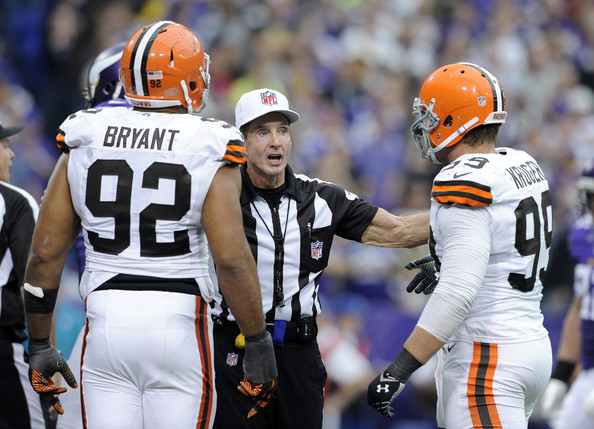The Browns’ release of veteran OLB Paul Kruger qualifies as a surprise, but it perfectly fits the new braintrust’s strategy for preparing the team for sustained success.
In our contest last week to predict the final 53-man roster, every single entry included Kruger, despite his age (30), salary ($6.5 million), and diminished production (2.5 sacks, 16 tackles in 2015, off from 11 and 36 the year before).
From this move and others, here’s what we think we know about the operating principles of EVP Sashi Brown and company (from ownership through the coaching staff):
Don’t cling to veteran players whose salaries are high and projected NFL lifespans are low.
This year they’ve already released WR Brian Hartline, SS Donte Whitner, ILB Karlos Dansby, TE Jim Dray, DL Randy Starks, and of course WR Dwayne Bowe. And that doesn’t even touch upon another half-dozen younger vets lost in free agency. Nor does it include today’s fellow casualties, QB Austin Davis and DL Nick Hayden. Kruger’s 2016 salary was to be $6.5 million, and that’s just too much given what he showed in the pre-season.
This bodes ominously for Tramon Williams, age 33 and set to earn $6.2 million in salary. If they deem the remaining cornerback depth chart survivable, don’t be shocked if they shell out his $2.8 million guaranteed portion and cut him loose too.
Vested veterans on the roster for Game 1 get their entire year’s salary guaranteed. That’s $1 million for WR Andrew Hawkins and $1.45 million for S Rahim Moore. I doubt both of them suit up in Philadelphia on September 11.
Players in their rookie contracts offer the most potential value and will get every opportunity to prove their worth.
That’s one big reason that the Browns have been loading up on draft picks and continue to do so. Most recently they added a late fifth-rounder in salvage for LB Barkevious Mingo, another underwhelming pass rusher a year away from free agency.
Reeling in Emmanuel Ogbah, Carl Nassib, and Joe Schobert in Rounds 2, 3, and 4 of this spring’s draft presaged the team cutting bait on Mingo and Kruger. Every roster spot spent on a declining older player is one fewer chance to develop a youngster essentially under team control through his fourth season.
Cam Johnson, a third-year OLB who spent most of last season on the practice squad, seems positioned to earn a job. He’d make the league minimum and be a restricted free agent next March.
The more players you can get a look at up close, the better the odds of finding a solid contributor.
Accumulating draft capital is part of this, but so is the consistent practice of churning the very bottom of the roster. Readily dropping or stashing injured players has allowed the Browns to bring in several prospects during camp. They maintain an active list of young players they’re ready to sign at a moment’s notice. Maybe a defensive lineman such as Kenton Adeyemi or Chigbo Anunoby will survive the final cuts.
Meanwhile, five young players are already on injured reserve and potentially in the mix to compete next year.
Expect this principle to play out as the waiver wire lights up in the the coming days. Don’t be surprised if several spots on the final 53 and practice squad go to newcomers, especially on defense.
Trust coaches to get the most out of the talent available, and make players earn their way onto the field.
To this new group, veteran leadership may matter, but it won’t save your job. If Josh McCown weren’t as field-ready as any QB in the room, he wouldn’t be here. It’s really the job of coaches to lead their positional groups, to coalesce those groups into strong units, and to unite them all under the Browns’ banner with purpose and pride.
Instrumental to the Browns’ strategy is true collaboration among the player pickers and the player developers. There’s not a definite “mold” of player that the scouts need to select among to fit the constraints of a particular scheme. From this widely-cast net, it’s then up to the coaches. They must capitalize on each player’s strengths, mitigate the weaknesses, foster healthy competition, and put the most talent together to best effect.
For interested observers of the 2016 Browns, that’s the fascinating focal point. How are Hue and company bringing along their young charges, setting them up for success, and creating a culture of excellence?
My prediction?
Slowly.
P.S. Kruger earned $27 million from the Browns since his 2013 signing as a UFA. That’s $1.5 million per sack. For his part, Mingo, the sixth-overall pick that year, received about $15.7 million (assuming the Browns paid his 2016 roster bonus), or $2.2 million per sack. Kruger’s obviously displeased by today’s news:
— Paul Kruger (@pkruger99) August 29, 2016
